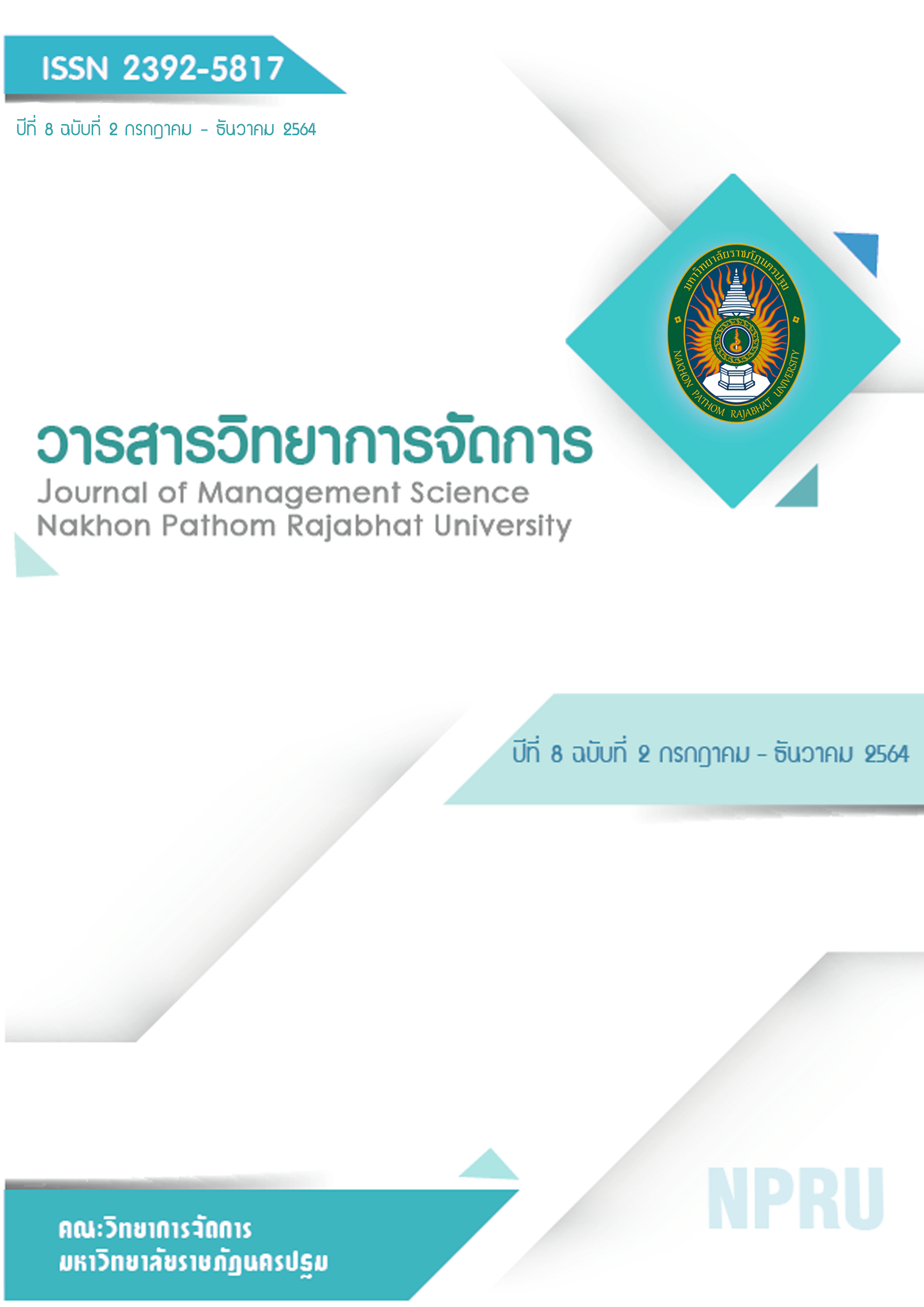The Effect of Using Training Program for Enhancing Knowledge to Successful Aging Behavior
Main Article Content
Abstract
The objectives of this research were to 1) develop training program for enhancing knowledge to successful aging behavior 2) study the effect of using training program for enhancing knowledge to successful aging behavior. The research was quasi experimental design. The elders aged 60–69 years for 35 elders participated throughout the research. The elders were self-assessed to have successful aging behavior. The data was analyzed in term of frequency, percentage, mean, standard deviation, and paired t – test. The results from this research indicated that as following:
1. Training program for enhancing knowledge to successful aging behavior was two phases. First phase was training program development by review literature and focus group discussion with stakeholder. Second phase was try out the training program, divided into 5 units, which are physical health, mental health, spiritual development, social support and independence for thirty hours using various training methods. Finally, successful aging behavior was assessed after one month of training.
2. The results of using the training program were as follows:
2.1 The learners had knowledge higher than before participation in training program with statistical significance at the level of .01.
2.2 The learners had successful aging behavior higher than before participation in training program with statistical significance at the level of .01.
Article history : Received 12 June 2020
Revised 10 August 2020
Accepted 14 August 2020
SIMILARITY INDEX = 0.00 %
Article Details
The views and opinions of the article appearing in this journal are those of the author. It is not considered a view and responsibility of the editorial staff.
References
ประนอม โอทกานนท์ รัชนีภรณ์ ทรัพย์กรานนท์ วารี กังใจ และสิริลักษณ์ โสมานุสรณ์. (2557). การพัฒนาหลักสูตรฝึกอบรม เรื่องทักษะการจัดการความรู้ด้านการสร้างเสริมสุขภาพสาหรับผู้สูงวัย. วารสารวิทยาศาสตร์และเทคโนโลยี. 22(5). 716-730.
ประไพศิริ เชี่ยวสาริกิจ. (2555). คู่มือสูงวัยอย่างสมาร์ท. กรุงเทพฯ: มูลนิธิสถาบันวิจัยและพัฒนาผู้สูงอายุไทย (มส. ผส.).
ปิยะ ศักดิ์เจริญ. (2558). ทฤษฎีการเรียนรู้ผู้ใหญ่และแนวคิดการเรียนรู้ด้วยการชี้นำตนเอง: กระบวนการ เรียนรู้เพื่อการส่งเสริมการเรียนรู้ตลอดชีวิต. วารสารพยาบาลทหารบก. 16(1). 8-13.
พิเชษฐ ไพบูลย์ศิริ. (2555). การพัฒนาหลักสูตรฝึกอบรม เพื่อเพิ่มคุณภาพชีวิตผู้สูงอายุ. วารสารวิชาการ มหาวิทยาลัยอีสเทิร์นเอเชียฉบับสังคมศาสตร์ และมนุษยศาสตร์. 6(1). 191-199.
พิศุทธิภา เมธีกุล. (2554). ประสบการณ์การสูงวัยอย่างประสบความสำเร็จของผู้สูงอายุไทยที่มีสุขภาวะทางจิตสูง: การวิจัยเชิงคุณภาพแบบทีมผู้วิจัยเห็นชอบร่วมกัน. วิทยานิพนธ์ศิลปศาสตรมหาบัณฑิต สาขาวิชาจิตวิทยาการปรึกษา สาขาวิชาจิตวิทยาการปรึกษา จุฬาลงกรณ์มหาวิทยาลัย
มณฑา ไชยะวัฒน และวิเชียร ตันสุวรรณนนท์. (บรรณาธิการ). (2559). คู่มือหลักสูตรโรงเรียนผู้สูงอายุเขตสุขภาพที่ 5. ราชบุรี: ศูนย์อนามัยที่ 5 ราชบุรี กรมอนามัย.
วณิช นิรันตรานนท์ และศศิธร นิรันตรานนท์. (2555). การพัฒนาหลักสูตรการดูแลสุขภาพตนเองของผู้สูงอายุ : รูปแบบการฝึกอบรมการดูแลสุขภาพโดยใช้กิจกรรมพลศึกษา สุขศึกษา นันทนาการและวิทยาศาสตร์การกีฬา. อุดรธานี: สถาบันการพลศึกษา วิทยาเขตอุดรธานี.
ศศิมา พึ่งโพธิ์ทอง ทิพวรรณ ตั้งวงษ์กิจ อรนุช นุ่นละออง มยุรี บุญทัด และนันท์ชวัล คณาสุริยพัฒน์. (2562). ประสิทธิผลของโปรแกรมการปรับเปลี่ยนพฤติกรรมสุขภาพตามหลัก 3อ.2ส. ของผู้สูงอายุโรคความดันโลหิตสูง อำเภอสรรคบุรี จังหวัดชัยนาท. วารสารแพทย์นาวี. 46(3). 581-591.
สมพร กันทรดุษฎี เตรียมชัยศรี. (2562). สร้างเสริมสุขภาพด้วยสมาธิบำบัดแบบ SKT 1-7. [ออนไลน์]. ค้นเมื่อ 8 มกราคม 2562, จาก https://thaicam.go.th/wp-content/uploads/2019/06/14-2.pdf
สำนักงานส่งเสริมสวัสดิภาพและพิทักษ์เด็ก เยาวชน ผู้ด้อยโอกาส และผู้สูงอายุ. (2556). ชุดความรู้เพื่อการเตรียมความพร้อมเข้าสู่วัยสูงอายุที่มีคุณภาพ. กรุงเทพฯ: กระทรวงการพัฒนาสังคมและความมั่นคงของมนุษย์.
สำนักงานสถิติแห่งชาติ. (2557). การสำรวจประชากรสูงอายุในประเทศไทย พ.ศ. 2557. กรุงเทพฯ: บริษัท เท็กซ์ แอนด์เจอร์นัล พับลิเคชั่น จำกัด.
สำนักอนามัยผู้สูงอายุ กรมอนามัย. (2560). สมุดบันทึกสุขภาพผู้สูงอายุ. กรุงเทพฯ: ศูนย์สื่อสิ่งพิมพ์แก้วเจ้าจอม มหาวิทยาลัยราชภัฎสวนสุนันทา
สุธรรม นันทมงคลชัย. (2561). ผู้สูงอายุที่ประสบความสำเร็จ : บทเรียนเพื่อการเตรียมตัวที่ดี. [ออนไลน์]. ค้นเมื่อ 20 กรกฎาคม 2561, จาก http://phfh.ph.mahidol.ac.th/article.pdf.
อรทัย อาจอ่ำ. (2553). แก่แล้วไม่มีคุณค่าจริงหรือ?บทสังเคราะห์ความรู้เกี่ยวกับคุณค่าของผู้สูงอายุ. การประชุมวิชาการระดับชาติครั้งที่ 6 สถาบันวิจัยประชากรและสังคม มหาวิทยาลัยมหิดล.
อัมพร เบญจพลพิทักษ์ กาญจนา วณิชรมณีย์ และพรรณี ภาณุ วัฒน์สุข. (2556). คู่มือความสุข 5 มิติสำหรับผู้สูงอายุ. นนทบุรี: สำนักพัฒนาสุขภาพใจ กรมสุขภาพใจ.
อุไร เดชพลกรัง. (2554). ทัศนะของนักศึกษามหาวิทยาลัยธรรมศาสตร์ต่อการเป็นผู้สูงอายุที่มีศักยภาพ. สังคมสงเคราะห์ศาสตรมหาบัณฑิต. การบริหารและนโยบายสวัสดิการสังคมมหาวิทยาลัยธรรมศาสตร์.
Cosco, T. D., Prina, A. M., Perales, J., Stephan, B. C., & Brayne, C. (2014). Operational definitions of successful aging: a systematic review. International Psychogeriatrics, 26 (3), 373-381.
Dahany, M. M., Dramé, M., Mahmoudi, R., Novella, J. L., Ciocan, D., Kanagaratnam, L., & Jolly, D. (2014). Factors associated with successful aging in persons aged 65 to 75 years. European Geriatric Medicine. 5(6). 365-370.
DeNisi, A. S., & Griffin, R. W. (2008). Human Resource Management. Boston: Houghton Mifflin Company
Dessler, G. (2013). Human resource management. (13th ed.). USA: Pearson Education.
Gwee, X., Nyunt, M. S. Z., Kua, E. H., Jeste, D. V., Kumar, R., & Ng, T. P. (2014). Reliability and validity of a self-rated analogue scale for global measure of successful aging. The American Journal of Geriatric Psychiatry. 22(8). 829-837.
Hair, J. F., Black, W. C., Babin, B. J., & Anderson, R. E. (2010). Multivariate data analysis.
(7th ed.). Upper Saddle River, NJ: Pearson Prentice Hall.
Johnson-Conley, C.D. (2009). Using community-based participatory research in the development of a consumer-driven cultural competency tool. Ph.D. Thesis, University.
Kim, E. J. (2013). Accessing factor structure and construct validity of the successful aging inventory. Journal of Korean Academy of Nursing, 43 (4), 568-578.
Lesinski, M., Hortobágyi, T., Muehlbauer, T., Gollhofer, A., & Granacher, U. (2015). Effects of balance training on balance performance in healthy older adults: a systematic review and meta-analysis. Sports medicine, 45 (12), 1721-1738.
Noe, R. A., Hollenbeck, J. R., Gerhart, B., & Wright, P. M. (2011). Fundamentals of human resource management. (4th ed.). Boston: McGraw-Hill.
Osterlind, S. J. (2002). Constructing Test Items: Multiple-Choice, Constructed-Response, Performance, and Other Formats. (2nd ed.). NY: Kluwer Academic Publishers.
Rowe, J. W., & Kahn, R. L. (1987). Human aging: Usual and successful. Science. 237. 143-149.
Rowe, J. W., & Kahn, R. L. (1997). Successful aging. The Gerontologist. 37. 433-440.
Russell, S. S. (2006). An overview of adult-learning processes. Urologic nursing. 26 (5). 349-352.
Tate, R. B., Loewen, B. L. , Bayomi, D. J. , and Payne, B. J. (2009). The Consistency of Definitions of Successful Aging Provided by Older Men: The Manitoba Follow-up Study. Canadian Journal on Aging, 28 (4), 315– 322.

